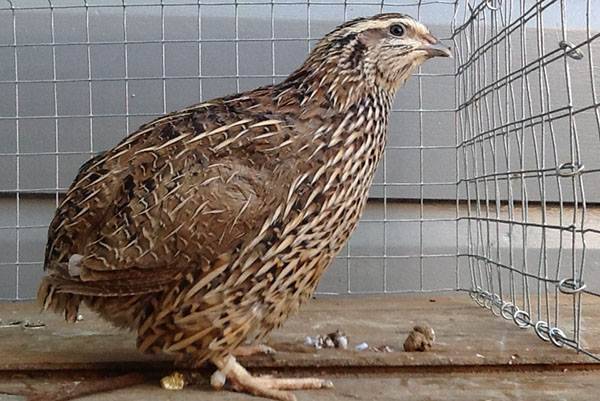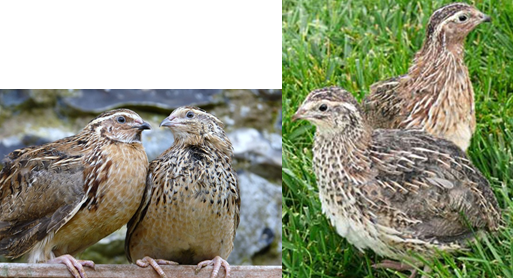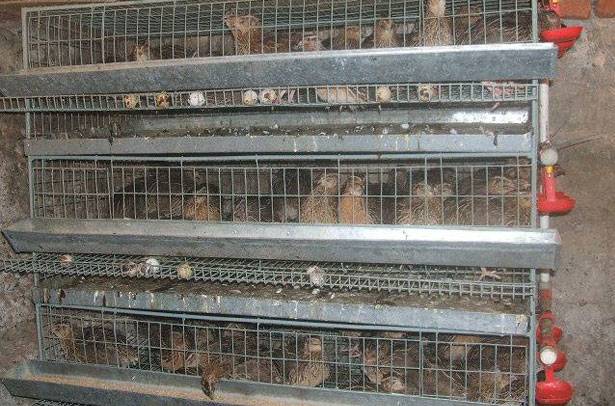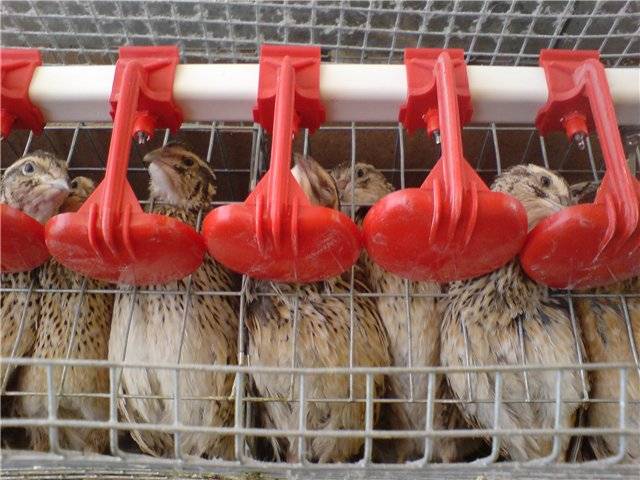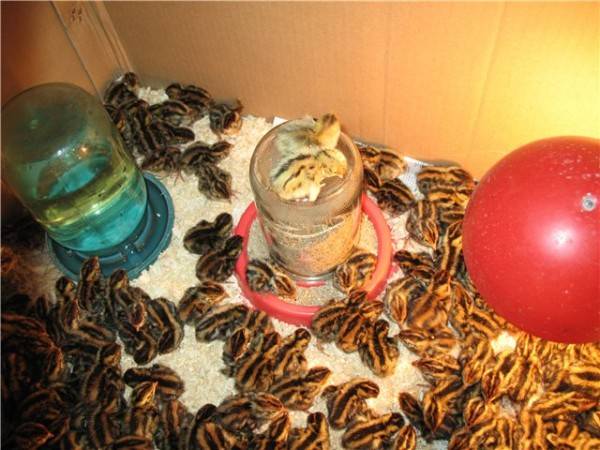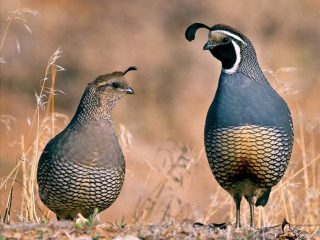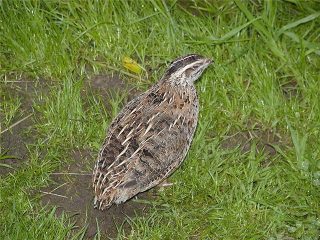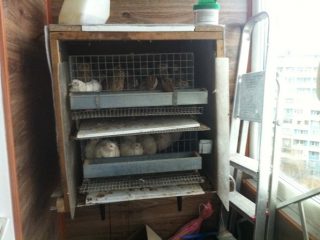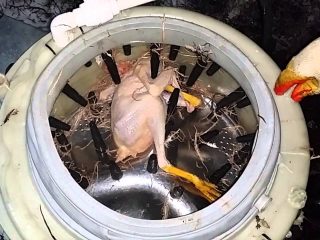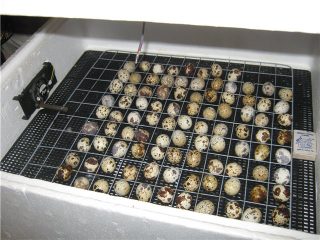Content
Quail of the Pharaoh breed is a classic example of the development of a new breed through an exceptionally long selective selection of Japanese quail for the desired trait without the infusion of any “alien” blood. The official version of the appearance of this quail breeds: the culinary industry's need for larger quail carcasses.
Although it is possible that this is due to the gigantomania inherent in Americans, from which not only quails, but also other animals suffer. Selection based only on size has led to a decrease in egg production, fertility, and undemanding conditions. Pharaohs are more capricious, the fertilization rate of eggs is lower than that of Japanese quail. Egg production has also declined.
Although the pharaohs lay a sufficient number of eggs so that this breed can be classified not as an exclusively meat breed, but as a meat-egg breed.
Description and productive characteristics of the Pharaoh breed
On the left in the photo is a Japanese quail, on the right is a pharaoh. Obviously, without a scale, just by the appearance in the photograph, it is impossible to understand which breed is which.
These breeds differ only in size.Therefore, if they sold you pharaohs, but they did not grow more than 150 g, this is not a bad breed, they sold you a Japanese quail.
In this case, you can console yourself that the Japanese breed is unpretentious, lays more eggs, has better preservation of the young, and find a restaurant to buy carcasses. Since restaurants prefer to take carcasses of Japanese or Manchurian quail, from which exactly one serving is made. Pharaohs are too big for a restaurant.
Otherwise, there is every chance of buying Japanese quails or a cross between Estonian quails and pharaohs.
The average weight of Pharaoh quail is 300 g. This is almost twice as much as Japanese quail. Pharaohs lay about 220 eggs per year. This is less than that of Japanese quails, but the eggs of the Pharaohs are much larger and weigh on average 15 g. Quails begin to lay eggs on the 42-50th day.
In many ways, the weight of the egg depends on the type of food that the quail receive. Thus, when feeding quails with broiler feed, the eggs are much larger. If the goal is to get a food egg and a herd laying hens Considered as a consumable item, this is a very good quality. If eggs are needed for an incubator, it is better not to get carried away with such methods. They destroy the bird’s body, and eggs that are too large are not suitable for the incubator.
The French pharaoh has the highest slaughter meat yield. The live weight of the French pharaoh can reach 500 g, although this is a record weight.Such quails are usually shown at exhibitions, and the average weight of the livestock is about 400 g.
The dark plumage of pharaohs is considered a disadvantage due to the fact that it spoils the color of the carcasses after plucking. Quail with dark feathers has dark skin and meat, which does not look very appetizing.
Other disadvantages of pharaohs include low egg production compared to Japanese quail and demanding maintenance.
At the same time, the advantages of the pharaoh cover up its disadvantages, for example, the advantages are: precocity, high weight of the marketable carcass and large eggs.
Overexposure until 7 weeks of age leads to excess feed consumption by 13%. At the same time, at 5 months, the growth of the quail already stops, but the carcass is not yet formed and has very thin bluish skin without fat. This carcass belongs to the 2nd category of fatness. By 6 weeks, the carcass acquires a marketable appearance with well-developed muscles and fat deposits on the neck, back and abdomen. This carcass is classified as fatness category 1.
Pitfalls of the Russian version of the breed
Or rather, even the entire CIS. In the former Soviet Union it is very difficult to find good representatives of the Pharaoh breed. This is due to the initial population being too small, which makes inbreeding and crushing of the bird inevitable, and the crossing of pharaohs with other quails that have the same plumage color. For example, with Estonian quail.
Features of keeping and feeding Pharaohs
Pharaohs, like large quails, require increased area, so 20 cm² are allocated for one pharaoh. The height of the cage in which the pharaohs are kept should be no more than 30 cm.
The room is maintained at a constant temperature of 20±2°C.When the temperature is too low, the quails huddle together and the outer ones constantly strive to get into the middle. If it is too high, both the birds and the eggs they lay overheat.
Then the continuous “necessary, but...” begins.
Quails need daylight hours lasting at least 17 hours. But the lighting should not be too bright, as quails become shy in bright light. A 60-watt light bulb is sufficient for a small room.
Air humidity must be maintained at 60-70%. If the air is too dry, place a bowl of water in the room. But humidity above 75% is critical for steppe birds.
Quails need constant flow of fresh air. In summer, the air exchange in the room should be 5 m³/hour. In winter, this standard is reduced three times. But in drafts, quails begin to get sick, lose feathers, reduce egg production and may die.
Food for the pharaohs
Due to the rapid weight gain of quail, Pharaohs especially need a balanced diet. The basis of their diet is grain feed, which should predominate ground millet, oats, corn and wheat.
In summer, quails can be given finely chopped grass, including sawdust. But to be on the safe side, it is better to exclude poisonous plants from the green mass. Birds have a very different metabolism from that of mammals and most often they eat poisonous plants and seeds without consequences for the body. These consequences then occur for the human body who has eaten a quail carcass or who has eaten poisonous seeds.
In winter, wheat and millet sprouts are added to quail feed. You can also give regular kitchen vegetables: cabbage leaves, grated beets and carrots, and other vegetables.
All year round, quail need ground eggshells, sand, limestone and table salt.
For young animals in the first two weeks of life they add grated boiled egg. A boiled egg can also be added to females, since they need more food, the nutrients of which are used for the formation of eggs.
This is all provided that the quails are fed the old fashioned way, without the use of special feed. When using special feed, quails do not need additional feeding. Everything necessary has already been added to the food.
Quails' water is changed every two days, since, quickly becoming contaminated with food residues, it turns sour in a warm room and can cause intestinal problems in the bird. If you want guarantees, then it is better to change the water every day. Any animal has a habit of going to drink immediately after eating and transferring the remaining food into the water.
Quail breeding
At quail breeding There are rules common to any breed:
- to avoid inbreeding, pairs are made up of unrelated birds taken from different flocks;
- One cockerel can have from 2 to 4 females. The ideal option is 3 quails for one quail;
- The upper age limit when quails are suitable for breeding is no older than 8 months. The lower age limit is 2 months;
- the maximum time during which quails are used to obtain hatching eggs is 3 months. The ideal option would be if the period ends when the quails are 20-22 weeks old.That is, birds should be placed for breeding at the age of 8-10 weeks. After 3 months, the quails are replaced with new ones.
Subject to the necessary conditions incubation The quails emerge from the eggs on the 17th day. Mistakes that can be made unknowingly during incubation are shown in the video.
